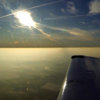Trever Oakes
Filing Flight Plan
- Joined
- Jul 10, 2019
- Messages
- 20
- Display Name
Display name:
KimJongUncle
I'm having trouble understanding why wind shear occurs in areas of temperature inversion.
I've been out on calm nights where I could see a layer of fog/smog which indicated a possible inversion.It is very calm aloft but when coming in for landing, it gets pretty bumpy sometimes.
Can someone explain how this works? I always thought of inversions as a calm atmospheric occurrence.
I've been out on calm nights where I could see a layer of fog/smog which indicated a possible inversion.It is very calm aloft but when coming in for landing, it gets pretty bumpy sometimes.
Can someone explain how this works? I always thought of inversions as a calm atmospheric occurrence.


